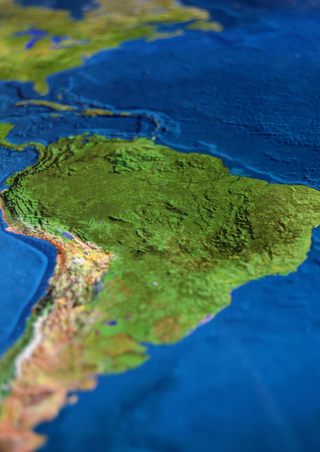Spirituality
Introducing Ayahuasca
Amazonian healing traditions collide with Western medical sensibilities.
Posted December 31, 2019 Reviewed by Ekua Hagan
What Is Ayahuasca?
You may have heard about an Amazonian brew called ayahuasca, a psychedelic traditional plant medicine that has been imbued with spiritual and psychological healing properties. Although ayahuasca is now currently coming into the public eye in the Western world, the tradition and ceremony surrounding this sacred plant medicine go back hundreds, maybe even thousands, of years.

Ayahuasca is made from two plants, the leaves of the Psychotria viridis shrub (chacruna) along with the stalks of the Banisteriopsis caapi vine (called ayahuasca, jagube, caapi, or yagé), though other plants and ingredients may be added as well. These two plants form the powerful ayahuasca brew that causes a non-ordinary state of consciousness that may include hallucinations, out-of-body experiences, and psychological insights.
What Happens in the Brain?
Psychotria viridis contains N,N-dimethyltryptamine (DMT), a psychedelic substance that occurs naturally in the plant. DMT is a powerful hallucinogenic chemical that is also considered a controlled substance. (There is natural DMT in your brain, too.) However, the plant itself has low bioavailability, as it gets rapidly broken down by monoamine oxidases (MAOs) enzymes in the liver and gastrointestinal tract. For this reason, DMT must be combined with a substance containing MAO inhibitors (MAOIs), which allows DMT to take effect.
Banisteriopsis caapi contains potent MAOIs called beta-carbolines, which also have psychoactive effects of their own. MAOIs not only inhibit the degradation of neurotransmitters such as serotonin and dopamine, but recent research suggests that the MAOI properties of Banisteriopsis caapi stimulate neurogenesis in adults (Morales-García, 2017). Neurogenesis in the adult hippocampus, combined with inhibition of monoamine degradation results in antidepressant effects in the brain. In fact, two recent clinical studies were conducted on patients with treatment-resistant depression, with findings that a single ayahuasca dose led to accelerated and long-lasting antidepressant effects (Sanches, 2016). The antidepressant properties of ayahuasca are only one avenue of study among the many properties of the traditional plant brew, however. There is strong evidence that the substance benefits patients with a variety of mental illnesses.
Although the ritual use of ayahuasca may seem mystifying to Westerners, there are well over 100 peer-reviewed articles in mental health journals exploring the benefits of ayahuasca for eating disorders, substance abuse, PTSD, and depression (e.g., Barros de Araújo, 2019). Additionally, ayahuasca has also been found to stimulate neurogenesis and enhance creative thinking while decreasing conventional convergent thinking (Morales-García et al., 2017). Indeed, ayahuasca may have a lot to offer.

Ayahuasca History and Religion
Evidence of ayahuasca use dates to over a thousand years ago from archaeological findings in southwestern Bolivia, although no one knows for certain exactly when the practice started. In the 16th century, Christian missionaries from Spain encountered indigenous people using ayahuasca in what is now modern Peru and Ecuador, and their earliest reports described it as the work of the devil. Even today there is cultural controversy surrounding the spiritual meaning and potential consequences of the substance.
Prior to ayahuasca ceremonies, participants are instructed to abstain from spicy foods, red meat, and sexual activities. Shamans lead the ayahuasca ceremony in a group setting that typically takes place over an entire night. Shamans and participants may smoke small natural tobacco cigars during the ritual called mapachos, as tobacco is also considered a powerful sacred plant. Over the course of the night, shamans sing chants called icaros which describe the movement of spirits or energies during the ceremony. The ceremony is usually accompanied by purging, which includes vomiting and diarrhea, believed to release negative energy.
In Brazil, several contemporary churches are based on the use of ayahuasca, the most well-known being Santo Daime and the União do Vegetal (Anderson et al., 2012). Santo Daime is now being practiced across Europe and North America. Deeming ayahuasca a dangerous substance, many Western governments have prohibited or persecuted those engaged in such practices. There has been much effort on the part of followers to gain legal use of ayahuasca in religious ceremonies. In the U.S. and more recently in Canada, ayahuasca churches have been permitted by governmental powers. In addition to churches with Brazilian roots, new versions of the faith have emerged, which includes a number of ayahuasca churches in Kentucky with no Brazilian connections or indigenous involvement. Some consider these new groups illegitimate whereas others consider them welcome modern incarnations of an ancient practice.

Ayahuasca Tourism
Due to the benefits of ayahuasca becoming popularized, there has (unsurprisingly) been an increase in people traveling to the Amazon seeking enlightenment and treatment for mental health problems. While it may be positive that the potential benefits and healing powers of the brew are being realized, the influx of travelers to the Amazon has not been without its negatives.
An ayahuasca ceremony can be intense and difficult, and so, it is necessary that an experienced shaman or healer facilitate the experience. However, due to increased publicity and demand in recent years, questionable groups are offering shady, fly-by-night ceremonies, lacking the experience and knowledge to properly administer the ayahuasca. This can lead to illness, death, or even sexual abuse by so-called "healers.” Like any other drug, ayahuasca should be administered by an adept, ethical, and experienced practitioner. With ayahuasca tourism, many of the ceremonial traditions are not respected or observed, with some worried it is being watered down or commercialized.
Many, however, believe the popularization of the drug is good for the region, bringing attention to the Amazon, celebrating the culture, and bringing more opportunities and economic growth. As the growing power of plant medicine is being realized, what these shamans in the Amazon have known for years is being appreciated on a broader scale.
There are many reasons people engage in ayahuasca tourism. The most common include mental health treatment, interest in exploring oneself, desire to explore psychedelic medicine, and finding new paths in life. Among the many benefits reported are spiritual awakening and development, self-knowledge, overcoming physical ailments, better interpersonal relations, and gaining new life perspectives (Kavenská, & Simonová, 2015). There is even an organization called the Heroic Hearts Project, that takes veterans to the Amazon to get treatment for their combat trauma and raise awareness for plant medicines in treating severe PTSD.
Summary
While ayahuasca might seem like a trendy new road to enlightenment, it is a serious substance that appears to have powerful benefits and some dangers as well. More research is needed to find out how ayahuasca works, and for whom this is a safe and beneficial option. More exploration is also required to see how it can be safely and legally incorporated into Western treatment approaches.
Learn more at Chacruna Institute for Psychedelic Plant Medicines.
By Zoe Jahn and Monnica Williams, Ph.D.
References
Anderson, B. T., Labate, B. C., Meyer, M., Tupper, K. W., Barbosa, P. C. R., Grob, C. S., … McKenna, D. (2012). Statement on ayahuasca. International Journal of Drug Policy, 23(3), 173–175.
Barros de Araújo, D. (2019). Evidence for the therapeutic effects of ayahuasca. In M. Winkelman & B. Sessa (Eds.), Advances in psychedelic medicine: State-of-the-art therapeutic applications. (pp. 102–123). Santa Barbara, CA: Praeger/ABC-CLIO.
Kavenská, V., & Simonová, H. (2015). Ayahuasca tourism: Participants in shamanic rituals and their personality styles, motivation, benefits and risks. Journal of Psychoactive Drugs, 47(5), 351–359.
Morales-García, J. A., de la Fuente Revenga, M., Alonso-Gil, S., Rodríguez-Franco, M. I., Feilding, A., Perez-Castillo, A., & Riba, J. (2017). The alkaloids of Banisteriopsis caapi, the plant source of the Amazonian hallucinogen Ayahuasca, stimulate adult neurogenesis in vitro. Scientific Reports, 7(1), 5309. doi:10.1038/s41598-017-05407-9
Sanches, R. F., de Lima Osório, F., dos Santos, R. G., Macedo, L. R., Maia-de-Oliveira, J. P., Wichert-Ana, L., ... & Hallak, J. E. (2016). Antidepressant effects of a single dose of ayahuasca in patients with recurrent depression: a SPECT study. Journal of Clinical Psychopharmacology, 36(1), 77-81.




